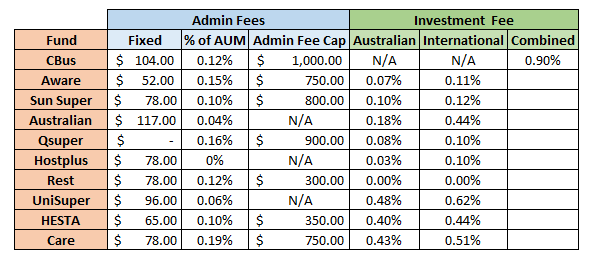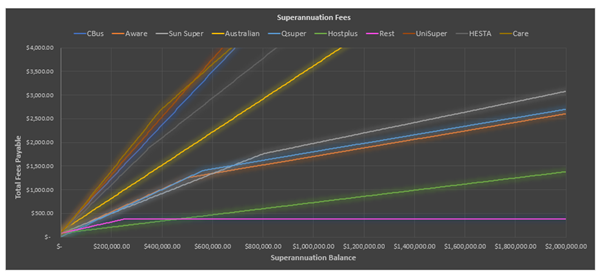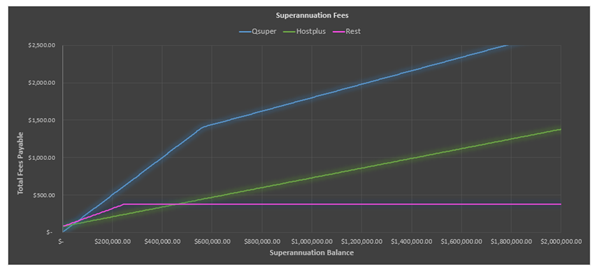Superannuation – Fee Comparison
Recently I have spent a bit of time looking into different Superannuation providers to find one with the lowest possible fees. I understand that performance is typically more important, but they are out of my control, whereas fees are known at least. If I can find a superannuation fund that invests in low-cost index funds, then I should still be able to achieve good returns, and if I can achieve that with the lowest possible fee, then that would be fantastic.
It can sometimes be difficult to see the full outlay of fees if you are only having a quick look on the surface with some providers. They are not necessarily hiding fees, but they might have an asterisk leading to more fees which are not immediately shown. For example, the superannuation provider that I was with Cbus had an additional fee that was not shown on the immediately obvious if you looked at the basic summary of their fees.
Once you do know what to look for however, it can be somewhat easy to navigate your way through and find the full breakdown of fees that you will be expected to pay.
In this post I will go through the following Superannuation providers, and each one below is a link to their fees.
Industry Superfunds
I was initially going to include a couple of Retail Superfunds as well, but they have significantly higher fees, and since the purpose of this post is to show the lowest fees, I have decided not to include them.
Summary of Fees
It should be noted that the fees are only approximate, and they will change over time. At the time of doing this (1st August 2021) the Superfunds had the following fees:

For each of the Superfunds I have assumed a 50/50 split between Australian and International low-cost Index Funds. The only exception to this was with CBus which does not have this option (at least not in their general superfunds), so I have used their investment fee for the high growth product.
As you can see, the fee amount varies quite considerably between the superfunds, so it can be important to know how the fee structure will impact the total fees paid as an individual.
It will be dependent on the individual balance as to what level of fees will be paid on the superfund.
Total Fees
Below is a table which summaries the fee amount based on different superannuation balances.

I have also highlighted in green the lowest fees payable at each $100,000 increment in superannuation balance. As you can see up to $400,000 the superfund with the cheapest fees is Hostplus, and after that it becomes Rest superannuation.
I like the idea of Rest because once you reach a certain threshold ($250,000) the total fees remain the same regardless of the superannuation balance.
Below is a graph which illustrates the above table in a different format.

It might look like there is a bit going on in the above graph, and while that is true. I have provided the following graph which removes all of the superfunds with higher fees.

In the above graph you can see the three superfunds which are the cheapest at different stages of your superannuation balance.
Now is the fun part of finding out where the breakeven point is between each Superfund so we can figure out what balance is required for one to be cheaper than the other. For this we can use some High School maths (this will mean I will really have to get my head thinking because it has been a long time since I have had to solve simultaneous equations).
Formula for each Superfund is as follows:
Qsuper: Fees = 0.25% x Balance (F = 0.0025B)
HostPlus: Fees = $78 + 0.065% x Balance (F = 78 + 0.00065B)
Rest: Fees = $78 + 0.12% x Balance (F = 78 + 0.0012B) : (with a maximum of $378)
There is also a maximum with QSuper, but we do not hit this threshold before the breakeven point so I will not worry about it.
This first breakeven point is between QSuper and HostPlus:
Fees will be the same when 0.0025B = 78 + 0.00065B
78 = 0.0025B – 0.00065B
78 = 0.00185B
$42,162.16 = Balance
The breakeven point between QSuper and HostPlus is just over $42,000.00.
The second breakeven point is between HostPlus and Rest:
From the graph, I can tell this occurs once Rest has reached the maximum fee of $378.00.
378 = 78 + 0.00065B
300 = 0.00065B
$461,538.46 = Balance
The breakeven point between HostPlus and Rest is just over $461,000.00
Summary of Finding the Cheapest Fees
From the above calculations we can see the following in terms of finding the cheapest superannuation provider.
$0.00 – $42,162.16 = QSuper
$42,162.16 – $461,538.46 = HostPlus
> $461,538.46 = Rest
Summary
As I said earlier, these fees are not constant and will be subject to change over time. I am merely providing a snapshot of what the current fees are right at the moment. I implore anyone who is reading this to do their own research when they want to find out the current fees for the different Superannuation Funds.
More importantly, I think it is imperative to also look into the cheapest options that are available within each Superannuation Fund, because quite often there are options which carry higher levels of fees, when cheaper alternatives are available, and it only takes a few button clicks to change it over.
For me, my Superannuation is currently sitting with HostPlus, and I plan to keep it there for a while yet. I will keep an eye on fees and potentially might have a look at changing when my Superannuation balance does reach around the $450,000.00 mark. At the moment, that level is quite a long way off, so I definitely have some time to think about it. I am sure by the time I reach that stage the fee structures between the Superfunds will change significantly as well.
Part 2 of this Series is Located HERE